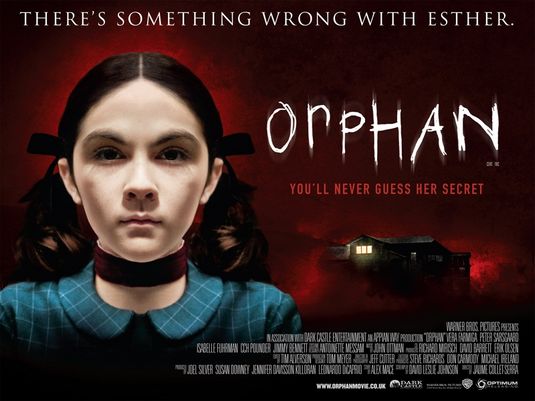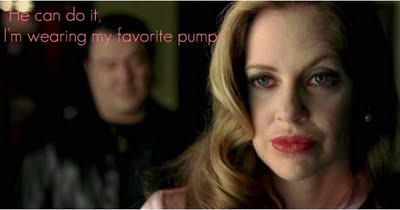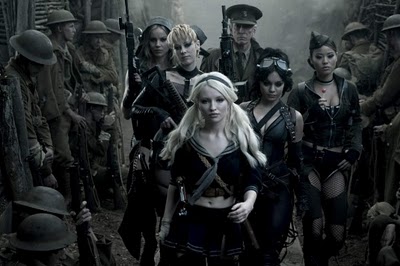This is a guest review by Tamara Winfrey Harris. Includes spoilers for Paranormal Activity (2007) and Orphan (2009).
There, outside the window, in the dark, are those eyes again. Yellow. Animal, but at the wrong height to be a coyote or fox–human height. And those amber, animal eyes are locked on hers. She slams shut the kitchen curtains and races to the living room window. The eyes are there, too, peering from the family’s wooded lot outside of town. Family. She thinks of her sleeping child down the hall and her heart beats faster. She shuts off the lights, hiding herself and her little girl from the gaze of whoever, whatever, is outside, and she dials the police. They arrive, lights flashing, just as her husband’s truck pulls into the driveway. They find nothing. The head cop chuckles, patting her on the shoulder, while looking at her husband, “Don’t worry. I think we just have a case of nervous wife here.”
Thank you, Paranormal Witness (Syfy, Wednesdays, 10 p.m. ET), for giving me a name for a ubiquitous horror trope. It goes like this: Woman begins to experience disturbing things. She shares this with her male partner (or other man), who responds by patronizing her, saying she is tired, silly, imagining things, nervous. It is only when the occurrences escalate and the male protagonist himself experiences something otherworldly that he will believe.
Call it The Nervous Wife, which is more concise than “women are super emotional, illogical and fearful and cannot be trusted.”
The Nervous Wife is a staple of the haunted house film genre, and now that paranormal shows are slowly taking over the small screen, it can be found there, too. In the first season of the FX channel’s American Horror Story, the character Vivien Harmon had to be committed and impregnated with a devil baby, and her teenage daughter dead and haunting the family abode, before her husband would believe that something spooky was going down.
Yes. Yes. I know. Science says ghosts and goblins and such don’t exist. True enough. It is natural for a body to be skeptical of supernatural claims. Would you believe it if you were told the portal to hell was in your laundry room? Likely not. The problem is that women in horror films are rarely, if ever, the skeptical ones. Logic is portrayed as a man thing. Little ladies are quick to believe the unbelievable. And to be frightened by it.
An example of this can be found in the horror juggernaut Paranormal Activity. In it, a young couple, Katie and Micah, live in a subdivision tract house that is plagued by threatening phenomena. Katie, who endured a brush with the supernatural as a child, is fearful and seeks relief from a psychic, who counsels that the best thing to do, until the home can be cleansed, is not to engage the spirit. In this instance, the male protagonist believes in the haunting; he does not, however, believe anyone’s advice on handling the problem. In a perfect illustration of male privilege and bullying in action, Micah dismisses the expert advice and laughs off Katie’s fear of an increasingly-menacing spirit. As his girlfriend becomes more frightened, Micah becomes more oblivious to her and her concerns. By the end of the film, their relationship feels uncomfortably emotionally abusive, with Katie withdrawing and Micah seemingly doing everything possible to provoke the thing that is terrorizing his mate.
On Facebook, my buddy Barry pegged The Nervous Wife trope as “a statement against the traditional macho sexism of the American male.” Bravado, aggression and ignoring the needs of others is a losing approach–at least against the supernatural. I think he may be right, but The Nervous Wife trope is still troubling, even if it is a deserved jab at patriarchy.
The problem is that the trope, while weirdly subversive, is ultimately regressive. The aforementioned narratives all embrace rigid, traditional gender lines for male and female protagonists. They then reject masculinity as ultimately useless and harmful. But why are they so invested in base, simplistic and incomplete illustrations of masculinity and femininity in the first place? The women I know are far braver and more logical than their horror flick counterparts; the men more caring and thoughtful. And while I know Hollywood is not real life, I also know that it is possible to draw complex fictional characters that are not caricatures of their respective genders.
For once, I’d like to hear a horror husband respond to his wife’s concerns with “Let’s call the cops and check that out!” (because you are normally a really smart and level-headed woman and I trust your judgment), or a solicitous miss calm her demon-plagued boyfriend with a “Darling, you’ve been working too hard. Perhaps you’re just nervous.”
Tamara Winfrey Harris is a freelance writer living in the Indianapolis area. Her work focuses on race and gender, and their intersection with pop culture and politics. She is currently senior editor at Racialicious and a contributor to Clutch and Frugivore magazines. Tamara is working on her first book–a feminist exploration of black women and marriage, and the sexist and racist underpinnings of the “black marriage crisis” narrative.
Learn more about Tamara and her work at her website.







